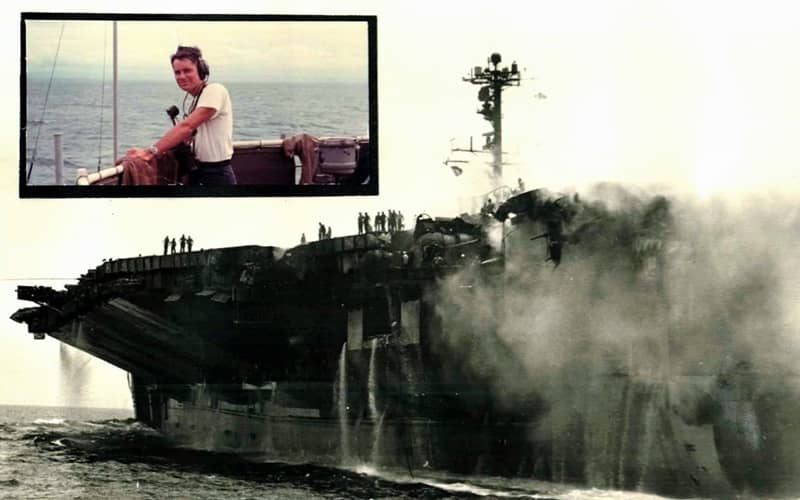By Mike E. Walsh
I returned to Oregon with a Combat Action Medal and a bruised psyche!
The Vietnam War was a big part of my youth, I was in my early twenties (1965-70). I had no plans to enter the military, and after graduating from Western Oregon University in 1965, I headed directly to a Peace Corps program at Teachers College, Columbia University, NY. However, instead of completing Peace Corps training for an assignment in Kenya: I was drafted to serve in the Army. I chose to enter the Navy, so I wouldn’t end up in the Vietnam War. Boy, was I wrong! I ended up serving aboard two destroyers Walke (DD723) and Rupertus (DD851); destroyers are the Navy’s go to offensive fire power for shore bombardment as well as aircraft carrier support.
The defining experience of my Navy service was off the coast of North Vietnam; on Saturday, July 29, 1967 the carrier Forrestal (CV59) was set ablaze when a rocket misfired on deck, shrapnel rupturing a fuel canister under, late senator, John McCain’s A-4 plane. He survived and a few months later was shot down over North Vietnam; he spent years as prisoner of war. My ship pulled alongside the Forrestal’s portside and sprayed water – saving many. However, 134 sailors died by fire, explosion, smoke or jumped overboard into the Gulf of Tonkin 150 miles northeast of the DMZ. I watched in horror as sailors jumped into the sea, and several planes were shoved overboard, too! I had just turned 24.
I’m pictured on Rupertus’ upper deck on watch, 10 minutes prior to the first explosion; it sent a black mushroom smoke cloud high above the Forrestal’s flight deck. We were following about 200 yards behind, and quickly advanced to the portside of the carrier as explosions continued spewing shrapnel in our direction; I took this iconic photo as we approached.
When not on carrier support Rupertus participated in “Sea Dragon” operations directed toward the interdiction of coastal water-born logistics craft, and highway traffic, moving supplies south in support of Viet Cong, (North Vietnamese troops) fighting in South Vietnam. It was during these operations that the Rupertus earned a reputation for possessing an unusually high magnetism for enemy fire. In four consecutive days in late 1968, off the coast of North Vietnam, near Dong Hoi and Tiger Island, we received over 400 rounds of hostile fire from coastal defense batteries. Each occasion on which the ship received hostile fire from the beach bunkers, our own guns, with five- inch shells, responded with telling effect on the shore batteries. Although vulnerable, as the ship approached within fifty yards off shore, we didn’t receive a direct hit, and had only minor damage from shrapnel. However, I found it very scary watching explosions only 20 feet off the starboard and port bow; I stood almost speechless, on the bridge, as phone talker, relaying the captain’s messages to fire our guns.
All of our missions off North or South Vietnam were just another day on the “Gunline.” In mid-1969 we spent days and nights patrolling off Phen Thiet village, 70 miles east of Saigon (Ho Chi Minh City). One afternoon, the Rupertus guns, with five-inch shells, destroyed or damaged 20 Viet Cong bunkers, seven military structures as well as secondary firing near Phen Thiet village. At midnight Rupertus peppered five-inch shells along the village’s perimeter to hold off possible Viet Cong infiltration attempts. Then at 4am Rupertus received an urgent call from our forces ashore; they requested fire support to suppress a Viet Cong rocket attack on the village. In reply, the Rupertus closed within 50 yards of the beach, and opened fire on the rocket sites. Minutes later it was all over; empty powder canister casings rattled on the forward deck as the ship rolled softly on the placid morning sea.
1969 was my last year in the Navy, and after hundreds of firing missions over nearly four years, I had come to the conclusion that the Vietnam War was a big mistake. So many young sailors and soldiers killed, not to mention the death toll of innocent civilians in both North and South Vietnam. I was beginning to question the USA’s role as the world’s police. I had answered the call to serve my country, even though I already had deep reservations when I first arrived off the shores of Vietnam.
In 2012 I made a final pilgrimage to Vietnam and found a youthful thriving culture with little left to remind me of the devastating war. I visited Ho Chi Minh City as well as the Cu Chi Tunnels – 125 mile-long-underground mazes, where thousands of Viet Cong fighters and villagers hid and fought; these locals refer to the war as the “American War.” It was a cathartic experience visiting the Ho Chi Minh City, War Remnants Museum; graphic images of civilian deaths: bodies slashed, piled high, burned – it broke my heart. My experiences in the Vietnam War turned me toward pacifism, I only support war as a last resort.
